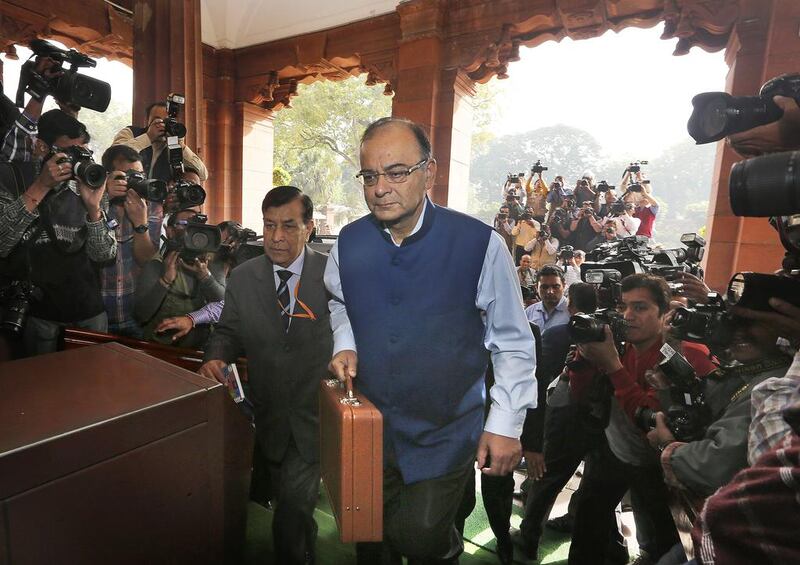NEW DELHI // India’s finance minister Arun Jaitley avoided expected sweeping economic reforms when presenting his government’s first budget on Saturday, setting the focus on economic growth instead of major change.
Prime minister Narendra Modi had swept to power in general elections last May, promising to cut both subsidies and the deficit, attract more investment, and revive a flagging economy by relaxing government control over the private sector.
In Mr Jaitley’s budget speech to parliament on Saturday, he outlined key investments in infrastructure and agriculture, although these were outnumbered by numerous tweaks to the tax code affect businesses. He admitted that he had to remain “mindful of the challenges” — primarily the fiscal deficit, or the gap between spending and income, and the need to continue spending on welfare subsidies.
“We inherited a sentiment of doom and gloom,” Mr Jaitley said. “The investment community had almost written us off. We have come a long way since then.”
“The world is predicting it’s India’s time to fly,” he said.
India’s government expects the economy to grow at between 8 and 8.5 per cent over the coming 2015-16 financial year, according to its annual economic survey released on Friday.
"I think a realisation has set in that private investment isn't happening, and so the government will have to step up public investment, and they've chosen to do this through infrastructure," John Samuel Raja, the founder of How India Lives, a firm that analyses public expenditure data, told The National.
The government plans to increase its investment in infrastructure by 700 billon rupees (Dh41.7bn) over the coming year. Previous governments have tended to shrink infrastructure spending to narrow the deficit and finance subsidies instead.
Over the past decade, public expenditure on roads, power plants and ports has slipped from 10 per cent to 6.2 per cent of total spending. In contrast, subsidies account for roughly 15 per cent of total spending now, as compared to 10 per cent a decade ago.
“This is no secret that the major slippage in the last decades is on the infrastructure front,” Mr Jaitley said. “Our infrastructure does not match our growth ambitions.”
Prominently, the budget provides for the construction of five mammoth power plants generating 4,000 megawatts apiece as well as an addition of 100,000 kilometres to India’s network of roads and highways.
Mr Jaitley also announced that India’s public sector banks will aim to lend 8.5 trillion rupees to farmers in 2015-16 — an increase of 500 billion rupees from the previous year.
“Farm credit underpins the efforts of our hardworking farmers,” Mr Jaitley said. He also allocated nearly 900 billion rupees to financing other government loan funds and to improving rural infrastructure, irrigation and soil fertility.
To compensate for this increased government expenditure, Mr Jaitley has delayed the government’s own targets for reducing its fiscal deficit.
When presenting an interim budget last July, Mr Jaitley promised that his government would slash the deficit to 3.6 per cent of the GDP in 2015-16. On Saturday, however, he said that the target would now be 3.9 per cent in the coming year, followed by 3.5 per cent in 2016-17 and 3 per cent in 2017-18.
The government, Mr Raja said, finds it difficult to manoeuvre within a space that has been limited by declining tax revenues caused by slowing inflation and lower levels of economic activity?.
“Right now, out of every 100 rupees that the central government earns in taxes, it has to transfer nearly two thirds of it to the states,” he said. “That leaves only 38 rupees for interest payments, pensions, salaries and other spending.”
Surprisingly, Mr Jaitley kept intact the previous Congress-led government’s programme of welfare subsidies, implicitly acknowledging the need for robust social security for India’s poor. These subsidies add up to trillions of rupees a year.
Mr Jaitley also allocated roughly 347 billion rupees to a fund that pays for a rural jobs guarantee scheme instituted by the Congress-led government in 2005. This was an increase of 50 billion rupees from the previous year.
Rather than cutting such welfare subsidies, Mr Jaitley said that his government was committed to reducing them by “cutting leakages” — a euphemism for weeding out corruption. He did not specify how he intended to do this.
To curb the menace of “black money” — untaxed money parked illegally in foreign bank accounts — Mr Jaitley said that such tax evaders would now face up to 10 years in prison and be required to pay penalties of 300 per cent of the value of these assets.
Nitin Jain, chief executive of global asset management at Edelweiss, a security firm, gave the budget a score of 7.5 out of 10, blaming disappointments primarily on the heightened anticipation of big-ticket reforms.
“The market expectations were really skyrocketing before this day,” Mr Jain said. The budget wasn’t anywhere close to the “visionary document” that investors wanted, he said, but “overall I would still say it is a well-balanced one.”
ssubramanian@thenational.ae





